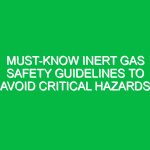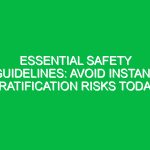“`html
Good Morning Team!
Today, we’re going to discuss a crucial topic that impacts many of us during our daily operations: Essential Guidelines for Managing Insect Sting Allergies Safely. With summer in full swing, the likelihood of encountering stinging insects increases, and understanding how to manage these allergies is vital for our Safety and well-being.
Understanding Essential Guidelines for Managing Insect Sting Allergies Safely
Insect sting allergies can lead to severe reactions, including anaphylaxis, which is a life-threatening condition that requires immediate medical attention. These reactions can occur within minutes of being stung and can affect anyone, regardless of prior exposure to stings. It’s essential to recognize the symptoms and take preventive measures to ensure a safe working environment.
Many employees mistakenly believe that insect stings are only a concern for those with known allergies. However, it’s important to understand that a person can develop an allergy at any time, and previous stings may not guarantee future immunity. Therefore, managing these allergies is everyone’s responsibility.
Key Hazards, Risks, and Safety Considerations
Identifying the Hazards associated with insect stings is the first step in managing them effectively. Here are some key risks:
- Exposure to Stinging Insects: Bees, wasps, hornets, and fire ants can all pose risks, especially in outdoor work environments or areas with vegetation.
- Allergic Reactions: Reactions can range from mild swelling and pain to severe anaphylaxis, which requires immediate action.
- Distractions: The presence of stinging insects can distract employees, leading to accidents and injuries.
Ignoring these risks can lead to severe consequences, including hospital visits and long-term health complications. Awareness and preparedness are key to preventing these incidents.
Best Practices, Procedures, & Actionable Advice
Here are some essential Best Practices to help you manage insect sting allergies safely:
- Know Your Allergies: Ensure that you and your coworkers are aware of any known allergies to insect stings. Consider keeping a list of employees with allergies readily available.
- First Aid Training: Ensure that all employees receive training on how to recognize allergic reactions and administer first aid, including the use of an EpiPen for severe reactions.
- Wear Protective Clothing: When working in areas where stinging insects may be present, wear long sleeves and pants. Light-colored clothing is less attractive to insects.
- Avoid Strong Scents: Avoid wearing perfumes, scented lotions, or brightly colored clothing that can attract insects.
- Keep Work Areas Clean: Dispose of food waste properly and keep work areas free of spills that may attract insects.
- Identify Nests: Be aware of potential nests near the workplace, and report them to management for safe removal.
For example, in a recent incident at a construction site, an employee was stung by a wasp while working near a flowering plant. Fortunately, he had an EpiPen on hand due to his known allergy, and coworkers were trained to assist him. This quick action prevented a potentially life-threatening situation.
Regulations, Standards, and Compliance
Compliance with safety Regulations is crucial for protecting employees from the hazards of insect stings. Here are a few relevant standards:
- OSHA Regulations: The Occupational Safety and Health Administration (osha) provides guidelines for maintaining a safe workplace, which includes managing environmental hazards such as stinging insects.
- Company Policies: Familiarize yourself with company-specific policies regarding allergies and emergency Procedures.
Why is compliance critical? It ensures that everyone understands their roles in maintaining safety, reduces liability, and promotes a culture of health and safety within the workplace.
Employee Engagement & Discussion
Now, let’s open the floor for discussion. Think about your experiences:
- Have you or a coworker ever experienced an allergic reaction to an insect sting? What did you learn from that experience?
- What challenges have you faced in managing insect stings while at work?
Your input is valuable in shaping our safety protocols and ensuring everyone feels secure in our work environment.
Conclusion & Key Takeaways
In conclusion, managing insect sting allergies safely is a shared responsibility that requires awareness, preparation, and adherence to Best Practices. Here are the key takeaways:
- Know your allergies and those of your coworkers.
- Receive proper training on how to respond to allergic reactions.
- Maintain a clean work environment to minimize insect attraction.
- Report any nests or potential hazards immediately.
By prioritizing these Safety Measures, we can create a safer workplace for everyone. Thank you for your attention and commitment to safety. Remember, your health and safety are paramount, so let’s work together to ensure we manage these allergies effectively!
“`


